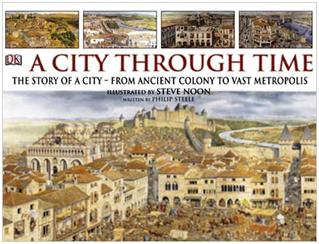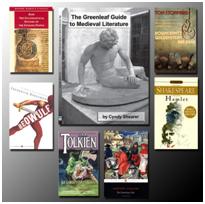I am, in general, a big fan of the DK books. Their Eyewitness series, with 160+ titles now, is an excellent resource for young readers (approximately 8-16) on a wide variety of topics. I’m busily adding all of the Eyewitness books into their own category in the Greenleaf online store. But beyond the Eyewitness books, with their museum quality photography, DK has also done some excellent development in traditional illustrated children’s books.
Parents, teachers, and students who will be tracing the history and connectivity of peoples and places from ancient through medieval and modern times will find the following two books very intriguing. They will definitely help your students to understand how the past still influences and is visible in the present.
 The first title is A Street Through Time, by Dr. Anne Millard and Steve Noon. It is billed as a 12,000-year walk through history. The book focuses on a location somewhere in the island of Britain, along a river and presents a detailed over-sized two-page spread which depicts what the place looked like at fourteen key periods of history. The first picture is labeled 10,000 BC. We can pass lightly over this one, since it’s largely guess-work. The second scene is 2,000 BC and shows farmers who have constructed a simple village. By 600 BC, this village has passed into the iron age and grown in population. On a nearby hilltop is an iron-age fort similar to those found throughout southern Britain. In AD 100 our village has become an outpost of the Roman Empire. There is a Roman bath, a Roman temple, and a Roman market. In AD 600, things have slipped backwards. The Romans are gone, their buildings are in ruins. But the place by the river is still inhabited. In 900 AD things have gotten both better and worse. There is a stone church and new thatched residences, but there is also the threat of Viking raids. Our scene shows such a raid in progress. In 1208 AD, we have reached the high middle ages. The village has grown a bit. There is a castle on the hill now. In 1400 AD the village has turned into a town. There is a new stone church, new town walls, and a new stone bridge. The townsmen are prospering. In 1500 AD, the plague strikes. It’s not a pretty scene. The next scene is labeled 1600’s finds our town caught in the conflict between King and Parliament – civil war in fact. Some of the houses are burning, the castle on the hill is under siege, and there are soldiers marching in the fields outside the town walls. The 1700s are much more prosperous, even elegant. The residences along the river have been rebuilt. The castle is in ruins, but there is a Georgian estate constructed beside it. The 1800s show the effect of the industrial revolution. The effect on the town is mixed. Some prosper, but many of the workers are poor (grim times). The last two scenes show our familiar street in the late 1800s and today. The church is still there – a landmark to help us orient ourselves. The castle is in ruins, but has become a tourist attraction.
The first title is A Street Through Time, by Dr. Anne Millard and Steve Noon. It is billed as a 12,000-year walk through history. The book focuses on a location somewhere in the island of Britain, along a river and presents a detailed over-sized two-page spread which depicts what the place looked like at fourteen key periods of history. The first picture is labeled 10,000 BC. We can pass lightly over this one, since it’s largely guess-work. The second scene is 2,000 BC and shows farmers who have constructed a simple village. By 600 BC, this village has passed into the iron age and grown in population. On a nearby hilltop is an iron-age fort similar to those found throughout southern Britain. In AD 100 our village has become an outpost of the Roman Empire. There is a Roman bath, a Roman temple, and a Roman market. In AD 600, things have slipped backwards. The Romans are gone, their buildings are in ruins. But the place by the river is still inhabited. In 900 AD things have gotten both better and worse. There is a stone church and new thatched residences, but there is also the threat of Viking raids. Our scene shows such a raid in progress. In 1208 AD, we have reached the high middle ages. The village has grown a bit. There is a castle on the hill now. In 1400 AD the village has turned into a town. There is a new stone church, new town walls, and a new stone bridge. The townsmen are prospering. In 1500 AD, the plague strikes. It’s not a pretty scene. The next scene is labeled 1600’s finds our town caught in the conflict between King and Parliament – civil war in fact. Some of the houses are burning, the castle on the hill is under siege, and there are soldiers marching in the fields outside the town walls. The 1700s are much more prosperous, even elegant. The residences along the river have been rebuilt. The castle is in ruins, but there is a Georgian estate constructed beside it. The 1800s show the effect of the industrial revolution. The effect on the town is mixed. Some prosper, but many of the workers are poor (grim times). The last two scenes show our familiar street in the late 1800s and today. The church is still there – a landmark to help us orient ourselves. The castle is in ruins, but has become a tourist attraction.
Among the other fun things to do with this book is to play a sort of “Where’s Waldo?” game. The illustrator has hidden a time traveler, named Henry Hyde in each scene. He keeps the same costume through the ages, and you can recognize him by the goggles on his head, his scarf, and long duster.
There are also text cues in the sentences printed in the margins that direct the reader to find particular features. A teacher or parent could use these very effectively with a child. An older student will enjoy the challenges on their own.
The book is oversize, 14″ x 10″, making each 2-page spread a full 28″ wide.
A Street Through Time is a hardback, 32 pages, with full-color illustrations throughout. It is available for $17.99 direct from Greenleaf.
 The second DK book is constructed on the same pattern as A Street Through Time, but takes a broader view. A City Through Time is billed as “The Story of a City – from Ancient Colony to vast Metropolis.” The setting for this book is somewhere in Europe, at the mouth of a river on the Mediterranean coast – though the precise location is never specified. Rather than give an identical view for each snapshot in time, the depiction of the city in these spreads is a bit more varied. This allows for a more detailed examination of particular features and buildings. The story begins with a Greek colony in 550 BC (with a separate spread on the Greek temple), then continues to Roman civitas (again with a separate spread showing the public baths in great detail). There is a view of the medieval city (with detail on the castle) and then the more modern industrial port (and railroad station) and the steel and glass modern city (with a cutaway view of a skyscraper turned on it’s side).
The second DK book is constructed on the same pattern as A Street Through Time, but takes a broader view. A City Through Time is billed as “The Story of a City – from Ancient Colony to vast Metropolis.” The setting for this book is somewhere in Europe, at the mouth of a river on the Mediterranean coast – though the precise location is never specified. Rather than give an identical view for each snapshot in time, the depiction of the city in these spreads is a bit more varied. This allows for a more detailed examination of particular features and buildings. The story begins with a Greek colony in 550 BC (with a separate spread on the Greek temple), then continues to Roman civitas (again with a separate spread showing the public baths in great detail). There is a view of the medieval city (with detail on the castle) and then the more modern industrial port (and railroad station) and the steel and glass modern city (with a cutaway view of a skyscraper turned on it’s side).
This one is also oversize, 14″ by 10″ making each 2-page spread a full 28″ wide.
A City Through Time is a hardback, 32 pages, with full-color illustrations throughout. It is available for $17.99 direct from Greenleaf.
– Rob Shearer
Publisher, Greenleaf Press

 Like the
Like the 

